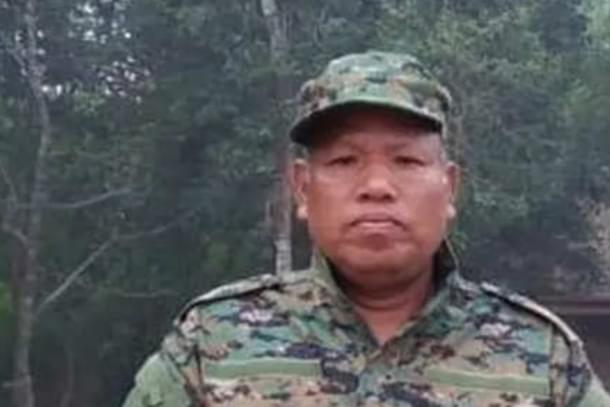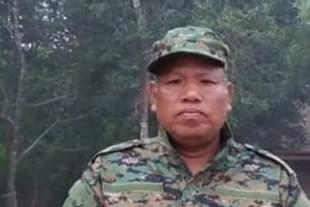Politics
Surrender Of Separatist Kamtapur Militant Outfit Chief Sets Off Political Churn And Speculation About North Bengal Being Given Special Status Soon
Jaideep Mazumdar
Jan 14, 2023, 05:01 PM | Updated 05:01 PM IST
Save & read from anywhere!
Bookmark stories for easy access on any device or the Swarajya app.


The surrender of the chief of the Kamtapur Liberation Organisation (KLO), Timir Das alias Jibon Singha, before the Assam Rifles in Nagaland Friday (January 13) afternoon has triggered political churn in North Bengal.
The KLO chief, who was sheltered in a camp in northwestern part of Sagaing province of Myanmar, entered Nagaland through Mon district and surrendered before the Assam Rifles which guards the 1600-kilometre-long India-Myanmar border.
Singha along with nine members of the proscribed outfit, surrendered before the ‘Mon Battalion’ of the Assam Rifles at Longwa in the Mon district. Top sources in the Ministry of Home Affairs (MHA) told Swarajya that the KLO chief has been flown to New Delhi for ‘peace talks’.
The surrender of the KLO chief in Nagaland, and his immediate transportation to New Delhi for peace talks, has set off political churn in Bengal.
The KLO has been waging an armed struggle since 1995 for formation of a separate Kamtapur state comprising six districts of North Bengal (Malda, North Dinajpur, South Dinajpur, Darjeeling, Jalpaiguri and Cooch Behar) and parts of four contiguous districts of Assam (Dhubri, Goalpara, Kokrajhar and Bongaigaon) for the Koch-Rajbongshi people.
The KLO contends that the Koch-Rajongshis were the original inhabitants of all these districts and have been reduced to a minority in their ‘homeland’ by successive waves of largescale migration from Bangladesh.
The boundaries of the ‘Kamtapur’ state demanded by the KLO conforms roughly to the boundaries of the erstwhile Kamata kingdom that was established in the late 13th century CE.
This kingdom became the princely state of Cooch Behar during the British raj.
The Cooch Behar state became part of the Union of India following a merger agreement signed on August 28, 1949 (read this) and was merged with Bengal in January 1950.
The KLO, which is responsible for many violent incidents in Bengal, contends that the Koch-Rajbongshis have been marginalised and discriminated against, especially in Bengal.
Why the surrender has triggered political churn
It is apparent that the Union Government as well as the Assam government had prior knowledge of Singha’s surrender. The Bengal government was kept out of the loop.
Singha issued a statement after his surrender that he would hold “bilateral talks” with the Union Government immediately. The Bengal government was not even mentioned.
Two days before his surrender, Singha emailed a statement to various media outlets in the Northeast region stating that the preparation for holding talks for a separate Kamtapur state are “almost at the final stage” and that discussions with Prime Minister Narendra Modi and Union Home Minister Amit Shah will “start soon”.
Singha, in his statement, also thanked Assam Chief Minister Himanta Biswa Sarma for mediating in the matter.
The statement read: “In this New Year 2023, I am very happy to inform you that the process of bilateral discussions between the Government of India and Kamtapur Liberation Organisation (KLO) has reached its final stage under the able leadership of Narendra Modi Ji, Hon'ble Prime Minister of India and Amit Shah Ji, Hon'ble Union Home Minister of India with active mediation from Himanta Biswa Sharma, Hon'ble Chief Minister of Assam”.
The KLO chief’s statement came close on the heels of a message he sent to mediapersons on 9 December last year claiming that the formation of a separate state of Kamtapur “is just a matter of time”.
All this has set off speculation that a final settlement with the KLO is perhaps in the offing. Though a separate state of Kamtapur is not likely to be conceded, not as yet anyway, leaders of the Kamtapur movement claim that large parts of North Bengal are likely to be declared a Union Territory.
A senior leader of the Kamtapur People’s Party (KPP), which is spearheading the movement for a separate state, claimed a few days ago that the Union Government would make a major announcement on Kamtapur by January 26.
BJP leaders of North Bengal have also been hinting for some time that a political solution to the Kamtapur state demand is round the corner. The ruling Trinamool Congress is vehemently opposed to any move to bifurcate Bengal or hive off any part of the state into a separate Union Territory.
The Bengal government had, in a bid to assert its stake in the process of negotiations with the KLO, announced the surrender of KLO general secretary Kailash Koch alias Keshab Barman before state police chief Manoj Malviya in Kolkata in August last year.
Koch, who ‘surrendered’ along with his wife on August 18, 2022, had appealed to all cadres of the outfit to surrender to the Bengal government. But the surrender was described as a farce by KLO chief Jibon Singha.
In a video released from his hideout in Myanmar, Singha said that Koch (who was his second-in-command) was deported from his hideout in Bangladesh by the authorities of that country and handed over to the Bengal police sometime in April-May last year. “The surrender is a stage-managed ceremony by the Bengal government which has been discriminating against and suppressing Koch-Rajbongshis,” the KLO chief had said.
The fact that Singha’s surrender was facilitated by the Assam chief minister and he was whisked off to New Delhi for talks by keeping the Bengal government completely out of the loop indicates that the Union Government does not want to involve Bengal too closely in negotiations with the KLO.
That is because the Bengal government is strongly opposed to any sort of compromise with the KLO or any other organisation that can affect the territorial integrity of the state. But New Delhi is only too aware that the Koch-Rajbongshis as well as the Gorkhas do not want to remain part of Bengal.
An amicable political solution to the statehood demands of the two communities is imperative since they inhabit the strategically sensitive Siliguri corridor that connects the Northeast with the rest of the country.
Jaideep Mazumdar is an associate editor at Swarajya.





